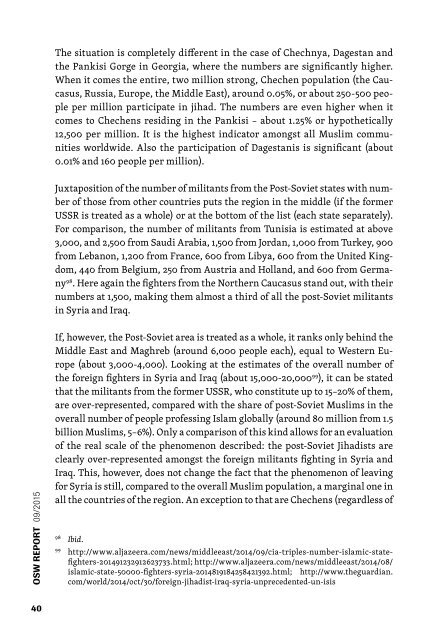HOMO JIHADICUS
homojihadicus
homojihadicus
Create successful ePaper yourself
Turn your PDF publications into a flip-book with our unique Google optimized e-Paper software.
The situation is completely different in the case of Chechnya, Dagestan and<br />
the Pankisi Gorge in Georgia, where the numbers are significantly higher.<br />
When it comes the entire, two million strong, Chechen population (the Caucasus,<br />
Russia, Europe, the Middle East), around 0.05%, or about 250-500 people<br />
per million participate in jihad. The numbers are even higher when it<br />
comes to Chechens residing in the Pankisi – about 1.25% or hypothetically<br />
12,500 per million. It is the highest indicator amongst all Muslim communities<br />
worldwide. Also the participation of Dagestanis is significant (about<br />
0.01% and 160 people per million).<br />
Juxtaposition of the number of militants from the Post-Soviet states with number<br />
of those from other countries puts the region in the middle (if the former<br />
USSR is treated as a whole) or at the bottom of the list (each state separately).<br />
For comparison, the number of militants from Tunisia is estimated at above<br />
3,000, and 2,500 from Saudi Arabia, 1,500 from Jordan, 1,000 from Turkey, 900<br />
from Lebanon, 1,200 from France, 600 from Libya, 600 from the United Kingdom,<br />
440 from Belgium, 250 from Austria and Holland, and 600 from Germany<br />
98 . Here again the fighters from the Northern Caucasus stand out, with their<br />
numbers at 1,500, making them almost a third of all the post-Soviet militants<br />
in Syria and Iraq.<br />
PRACE OSW REPORT OSW 09/2012 09/2015<br />
If, however, the Post-Soviet area is treated as a whole, it ranks only behind the<br />
Middle East and Maghreb (around 6,000 people each), equal to Western Europe<br />
(about 3,000-4,000). Looking at the estimates of the overall number of<br />
the foreign fighters in Syria and Iraq (about 15,000-20,000 99 ), it can be stated<br />
that the militants from the former USSR, who constitute up to 15–20% of them,<br />
are over-represented, compared with the share of post-Soviet Muslims in the<br />
overall number of people professing Islam globally (around 80 million from 1.5<br />
billion Muslims, 5–6%). Only a comparison of this kind allows for an evaluation<br />
of the real scale of the phenomenon described: the post-Soviet Jihadists are<br />
clearly over-represented amongst the foreign militants fighting in Syria and<br />
Iraq. This, however, does not change the fact that the phenomenon of leaving<br />
for Syria is still, compared to the overall Muslim population, a marginal one in<br />
all the countries of the region. An exception to that are Chechens (regardless of<br />
98<br />
Ibid.<br />
99<br />
http://www.aljazeera.com/news/middleeast/2014/09/cia-triples-number-islamic-statefighters-201491232912623733.html;<br />
http://www.aljazeera.com/news/middleeast/2014/08/<br />
islamic-state-50000-fighters-syria-2014819184258421392.html; http://www.theguardian.<br />
com/world/2014/oct/30/foreign-jihadist-iraq-syria-unprecedented-un-isis<br />
40


